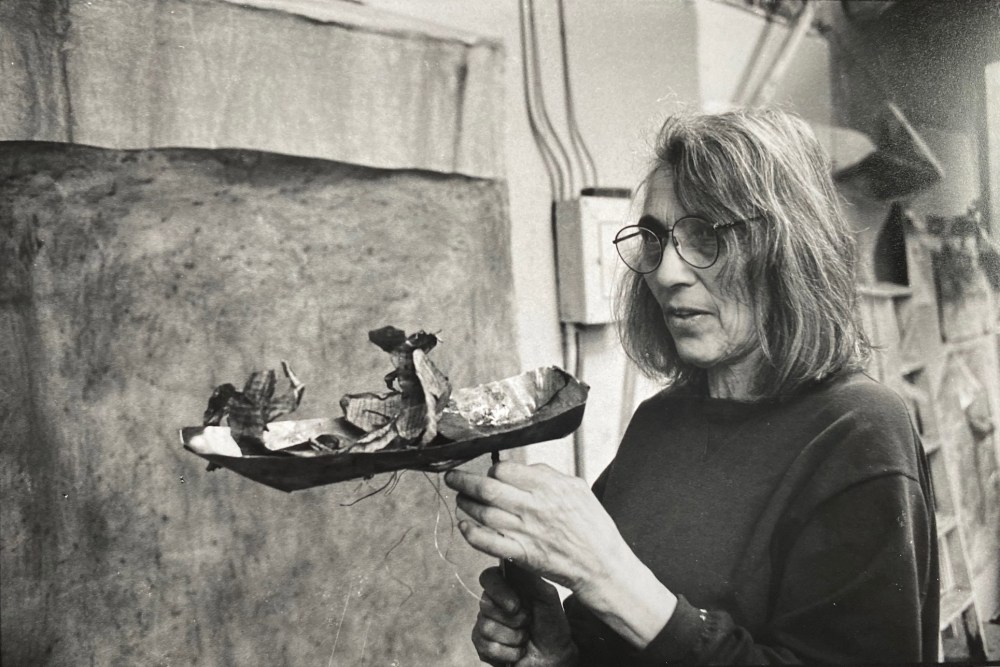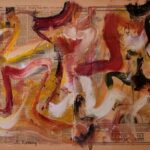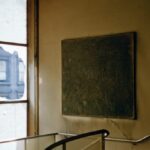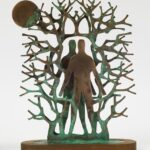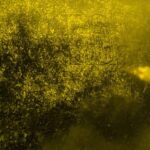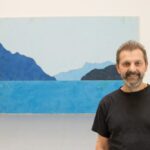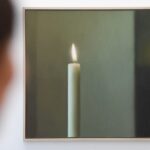June Leaf, whose idiosyncratic oeuvre was shaped by a desire to find new ways of seeing the world, died of gastric cancer on July 1 at her Manhattan home. She was ninety-four. Through poetic paintings, intimate drawings, and trembling kinetic sculptures, Leaf maintained a constantly evolving practice whose eternal freshness guaranteed its longevity and allowed her to stay outside the long shadow cast by her husband, Swiss-born photographer and filmmaker Robert Frank. Possessed of a vivid imagination, Leaf sought to bring its products to life. “It’s a search,” she told WWD’s Rosemary Feitelberg in 2016. “You can see that I’m searching. I realize that I don’t see that often in paintings. You see it in writing. Or maybe sometimes in the [choreography] in a dance where the dancers are portraying some evolution of their souls. I thought if all else fails this person is searching.”
References: this article is based on content originally published by News Desk on Artforum. You can read the full article here.
June Leaf was born August 4, 1929, in Chicago. Her parents owned a liquor store, though her father was an inveterate gambler, and Leaf would later acknowledge her mother as the source of her own tireless work ethic. Having gained an interest in making art herself at the age of three, when her mother could not render a high-heeled shoe exactly as Leaf had asked her to, she entered László Moholy-Nagy’s Institute of Design (formerly the New Bauhaus) at the age of eighteen. After studying under Swiss abstractionist Hugo Weber for a few months, she dropped out. “I decided I wasn’t going to stay in school because all the beautiful art is on the sidewalks, in the cracks, and in the cobblestones,” she told Hans Ulrich Obrist in a 2023 interview for Pin-Up magazine. “I [was] just going to follow that for the rest of my life.”
References: this article is based on content originally published by News Desk on Artforum. You can read the full article here.
In the wake of her first solo exhibition, at Chicago’s Sam Bordelon Gallery in 1948, Leaf decamped for Paris in hopes of discovering patterns in her work. After a brief experimental stint there, she returned to Chicago and to the Institute of Design, from which she received her MA in art education in 1954. Around this time, making paintings and drawings that were largely figurative—see, for example her Rocking Horse Women of 1956–60s, in which a pair of plump, comely women sit astride the toys of the title before the jagged wall and empty windows of an urban hi-rise—she fell in with the Monster Roster, a loose network of existentialist figurative artists including Leon Golub and his wife, Nancy Spero. Leaf went back to Paris in 1958, this time on a Fulbright scholarship, but found herself quailing before the grandeur of the old masters at the Louvre, where she was taking life-drawing classes. In 1960, she moved to New York. Five years later, she made her first sculpture, Vermeer Box, a spatially disorienting mirrored 3D re-creation of the Dutch artist’s ca. 1660 painting The Glass of Wine.
References: this article is based on content originally published by News Desk on Artforum. You can read the full article here.
“I tried to paint the woman first, but I couldn’t paint her,” she told Obrist. “I had to make dimensions that I couldn’t paint. That’s when I made my first sculpture—I made the woman out of mirrors, piece by piece. And I made the tabletop like a puzzle. I used comic strips to glue on the paper. And then I even made a hinge. It opened up what sculpture could do for me—it could go into another dimension. I’m an absolute mess of a sculptor. I go against every rule possible. I try to bend the materials, which I can’t do with painting.”
References: this article is based on content originally published by News Desk on Artforum. You can read the full article here.
Leaf’s inaugural solo show in New York took place in 1968 at Allan Frumkin Gallery, which would represent her throughout the ’60s and ’70s. Titled “Street Dreams” and peopled with marionettes and carousel horses, it gained her the attention of New York Times critic Hilton Kramer, who praised her theatrical sensibility and wealth of ideas. “She is that rare thing in painting today,” he wrote, “a poet with a taste and a talent for complex images.”
References: this article is based on content originally published by News Desk on Artforum. You can read the full article here.
Leaf in the 1970s brought that talent to bear in her drawings of robotics, which she began that decade. Typical of these is 1975’s Computer Woman in Landscape, in which a heavily penciled humanoid form and what appears to be a close-up of the figure, showing its inner workings, float above a patchy watercolor firmament, whose aqueous blues and greens suggest rivers and fields. That same decade, Leaf married Frank, whom she’d met through his then-wife, visual artist Mary Frank, and the pair moved to Mabou, in Nova Scotia. Leaf, who maintained a studio with Frank at Bleecker and Bowery in New York, continued to produce prolifically over the ensuing decades, churning out drawings of sphinxes, robots, women on horseback; paintings of fish, angels, a bird made of pencils; and tin sculptures of teetering figures, hovering wheels, a machine that makes itself. What drew this seemingly disparate group of works together was their shared evocation of possibility, of an impending future that was all at once delightful, forbidding, unknown.
References: this article is based on content originally published by News Desk on Artforum. You can read the full article here.
“What constitutes June Leaf’s genius also makes her something of a throwback or an anomaly, an artist whose work looks back, through that of Giacometti and Picasso, to the primitive impulse to make images,” wrote Barry Schwabsky in a 1995 issue of Artforum. “It would be easy to mistake Leaf’s modestly scaled objects for whimsies. In fact, the unconventionality of her work is actually born from an intense engagement with tradition that manifests itself as informality, as a certain distance from the dogmas, programs, and protocols of contemporary artmaking. Her works, with their mercurial, intimate bearing, make no claim to public significance, yet even in the smallest, most fragile constructions there is a hint of archetypal gravity, a touch of mythic grandeur.”
References: this article is based on content originally published by News Desk on Artforum. You can read the full article here.
Leaf enjoyed solo exhibitions at the Museum of Contemporary Art Chicago; Freedman Gallery, Albright College, Reading, Pennsylvania; the Whitney Museum of American Art, New York; Mount Saint Vincent University Art Gallery, Halifax, Nova Scotia; and the Tinguely Museum, Basel, among other institutions. Her work is held in the collections of museums including the Minneapolis Institute of Art; the Art Institute of Chicago and the Museum of Contemporary Art Chicago; the Museum of Modern Art, New York; Yale University Art Gallery, New Haven; the Smithsonian American Art Museum, Washington, DC; and the Tel Aviv Museum of Art.
References: this article is based on content originally published by News Desk on Artforum. You can read the full article here.
Though achieving wider renown comparatively late in her career, Leaf all her life seemed less interested than her supporters in making sure she received the credit she was due in the art world. “I want to survive with that integrity that is so precious to me,” she told WWD. “I guess I just want to live right.”
References: this article is based on content originally published by News Desk on Artforum. You can read the full article here.
